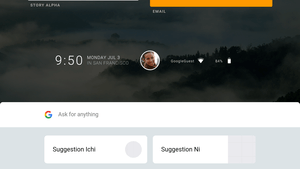Google Fuchsia
 | |
|
Screenshot of the Armadillo user shell, part of Fuchsia | |
| Developer | |
|---|---|
| Written in | Mixed: C, C++, Dart, Go, Rust, Python, Kotlin |
| OS family | Magenta |
| Working state | Current |
| Source model | Open-source |
| Initial release | 15 August 2016 |
| Available in | English |
| Platforms | ARM64, x86-64 |
| Kernel type | Microkernel capability-based RTOS |
| License | Mixed: BSD 3 clause, MIT, Apache 2.0 |
| Official website |
fuchsia |
Fuchsia is a capability-based, real-time operating system (RTOS) currently being developed by Google. It was first discovered as a mysterious code post on GitHub in August 2016, without any official announcement. In contrast to prior Google-developed operating systems such as Chrome OS and Android, which are based on Linux kernels, Fuchsia is based on a new microkernel called "Magenta", derived from "Little Kernel",[1][2] a small operating system intended for embedded systems. Upon inspection, media outlets noted that the code post on GitHub suggested Fuchsia's capability to run on universal devices, from embedded systems to smartphones, tablets and personal computers. In May 2017, Fuchsia was updated with a user interface, along with a developer writing that the project was not a "dumping ground of a dead thing", prompting media speculation about Google's intentions with the operating system, including the possibility of it replacing Android.
It is distributed as free and open-source software under a mix of software licenses, including BSD 3 clause, MIT, and Apache 2.0.
History
In August 2016, media outlets reported on a mysterious codebase post published on GitHub, that revealed that Google was developing a new operating system called "Fuchsia". While no official announcement was made, inspection of the code suggested its capability to run on universal devices, including "dash infotainment systems for cars, to embedded devices like traffic lights and digital watches, all the way up to smartphones, tablets and PCs". The code differs from Android and Chrome OS due to its being based on the "Magenta" kernel rather than on the Linux kernel.[3][4]
In May 2017, Ars Technica wrote about Fuchsia's new user interface, an upgrade from its command-line interface at its first reveal in August, along with a developer writing that Fuchsia "isn't a toy thing, it's not a 20% project, it's not a dumping ground of a dead thing that we don't care about anymore".[5] Multiple media outlets wrote about the project's seemingly close ties to Android, with some speculating that Fuchsia might be an effort to "re-do"[6] or replace Android[7][8] in a way that fixes problems on that platform.[5]
Features
Fuchsia's user interface and apps are written with "Flutter", a software development kit allowing cross-platform development abilities for Fuchsia, Android and iOS. Flutter produces apps based on Dart, offering apps with high performance that run at 120 frames per second. Flutter also offers a Vulkan-based graphics rendering engine called "Escher", with specific support for "Volumetric soft shadows", an element that Ars Technica wrote "seems custom-built to run Google's shadow-heavy "Material Design" interface guidelines".
Due to the Flutter software development kit offering cross-platform opportunities, users are able to install parts of Fuchsia on Android devices. Ars Technica noted that, while users could test Fuchsia, nothing "works", adding that "it's all a bunch of placeholder interfaces that don't do anything", though finding multiple similarities between Fuchsia's interface and Android, including a Recent Apps screen, a Settings menu, and a split-screen view for viewing multiple apps at once.[5]
See also
- Haiku OS – open-source desktop operating system
- FreeRTOS - industry-leading microkernel, real-time operating system (RTOS)
- QNX – POSIX-conforming, microkernel RTOS used in Blackberries
- Integrity (operating system) - microkernel RTOS with a top NSA security rating
- L4 microkernel family - L4 family of small, fast, open-source microkernels
- Plan 9 from Bell Labs - distributed OS meant to succeed UNIX
References
- ↑ Sims, Gary (August 17, 2016). "What we learned from running Fuchsia, the mysterious new OS from Google". Android Authority. Retrieved May 9, 2017.
- ↑ Mahate, Shakeel (October 24, 2016). "Introduction". GitHub. Retrieved May 9, 2017.
- ↑ Etherington, Darrell (August 15, 2016). "Google’s mysterious new Fuchsia operating system could run on almost anything". TechCrunch. AOL. Retrieved October 5, 2016.
- ↑ Fingas, Jon (August 13, 2016). "Google's Fuchsia operating system runs on virtually anything". Engadget. AOL. Retrieved October 5, 2016.
- 1 2 3 Amadeo, Ron (May 8, 2017). "Google’s “Fuchsia” smartphone OS dumps Linux, has a wild new UI". Ars Technica. Condé Nast. Retrieved May 9, 2017.
- ↑ Fingas, Jon (May 8, 2017). "Google's mysterious Fuchsia OS looks like an Android re-do". Engadget. AOL. Retrieved May 9, 2017.
- ↑ Gartenberg, Chaim (May 8, 2017). "Google’s mysterious new Fuchsia OS has a UI now". The Verge. Vox Media. Retrieved May 9, 2017.
- ↑ Davenport, Corbin (May 8, 2017). "Google's "Fuchsia" operating system is taking shape with a new design". Android Police. Retrieved May 9, 2017.
External links
- Official website, Google source code repository
- Fuchsia-mirror on GitHub
